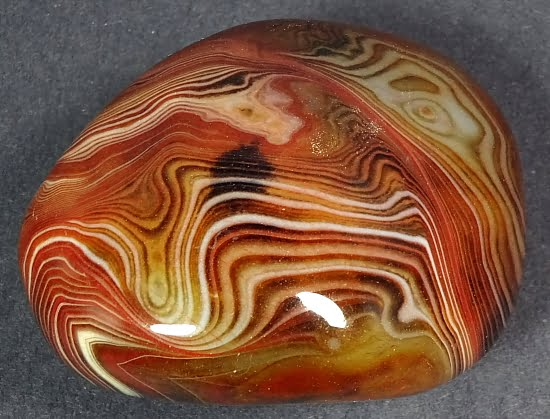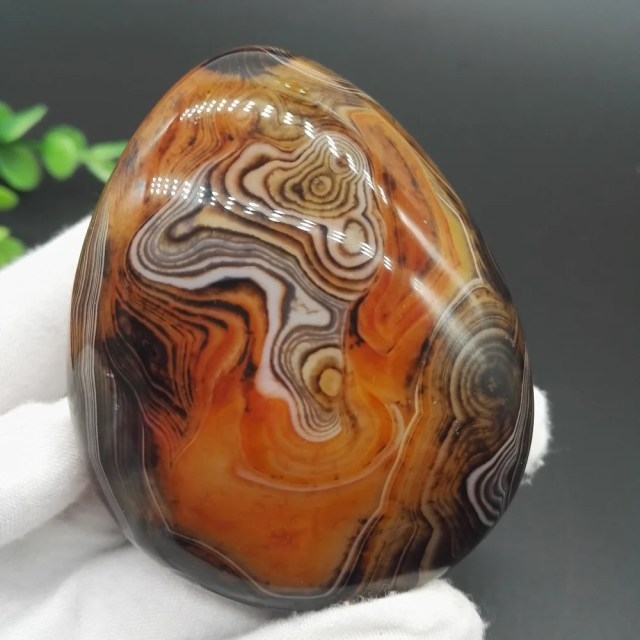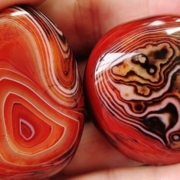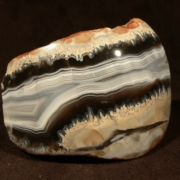Sardonyx
Sardonyx is a gemstone that belongs to the chalcedony family, which is a type of microcrystalline quartz. It is a variety of onyx, which itself is a type of chalcedony known for its banded appearance. Sardonyx is characterized by its distinctive layers of reddish-brown or orange-brown sard (a type of chalcedony with a reddish-brown color) and white or black onyx. These bands can create beautiful and intricate patterns within the stone.


The name “sardonyx” is derived from the Greek words “sard” (referring to the reddish-brown color) and “onyx” (meaning “claw” or “fingernail” in Greek), possibly due to its traditional use in carving cameos and intaglios.
Sardonyx has been valued for its aesthetic appeal and has been used in jewelry and ornamental objects for centuries. It has a long history of being used in engraved gems and seals, often bearing intricate designs or symbols. The contrasting colors of sardonyx make it a popular choice for creating striking jewelry pieces, and it has been used in various cultures throughout history.
In addition to its decorative use, sardonyx has also been associated with certain beliefs and properties. It is believed to have metaphysical properties that promote strength, courage, and protection. In some traditions, sardonyx is thought to bring stability, enhance self-control, and provide a sense of grounding. As with many gemstones, these metaphysical properties are based on cultural beliefs and should be approached with an open mind.
Sardonyx can be found in various parts of the world, including Brazil, India, Uruguay, and the United States. It is often cut into cabochons (smooth, rounded, and polished shapes) to showcase its distinct bands and colors. The gemstone’s appearance can vary widely, with some stones displaying more prominent bands and others having a more subtle layering effect.
Whether appreciated for its beauty, cultural significance, or potential metaphysical properties, sardonyx remains a captivating gemstone that continues to be cherished by collectors, jewelry enthusiasts, and individuals seeking meaningful connections to history and nature.
Contents
- Geological Formation and Occurrence
- Physical and Optical Properties
- Types and Varieties of Sardonyx
- Notable Sources of Sardonyx
- Historical Significance and Cultural Uses
- Sardonyx in Jewelry and Ornamental Art
Geological Formation and Occurrence

Sardonyx is a variety of chalcedony, which is a type of microcrystalline quartz. It forms through a combination of geological processes that involve the deposition of silica-rich solutions and the subsequent growth of quartz crystals. The distinctive banding of sardonyx is a result of alternating layers of different colors of chalcedony.
The exact geological formation of sardonyx involves the following processes:
- Silica Deposition: Silica-rich solutions, often containing dissolved quartz, flow through rock cavities and fractures. These solutions may be sourced from hydrothermal fluids, which are hot water solutions carrying minerals in suspension.
- Layer Formation: As the silica-rich solutions flow through cavities and fractures in the host rock, they start to deposit layers of chalcedony. The color of the chalcedony layers depends on the presence of various mineral impurities. In the case of sardonyx, the reddish-brown or orange-brown color comes from iron oxide (hematite) or iron hydroxide, while the white or black layers are typically caused by the presence of organic matter, manganese, or other minerals.
- Crystallization: Over time, the silica in the solutions starts to crystallize and form microcrystals of quartz. These crystals gradually grow within the deposited chalcedony layers, creating the characteristic banded pattern.
- Mineralization and Replacement: In some cases, sardonyx forms as a result of mineral replacement. The silica-rich solutions can replace existing minerals in the host rock, gradually transforming it into layers of chalcedony.
Sardonyx can be found in various geological settings, including:
- Veins and Fractures: Sardonyx often forms within veins and fractures in other rocks. These veins can cut through a variety of host rocks, such as limestone, basalt, and granite.
- Agate Geodes: Sardonyx can also form within the hollow cavities of geodes, which are spherical rock formations lined with crystals. The banding in sardonyx geodes can create stunning and intricate patterns when they are cut and polished.
- Sedimentary Rocks: Sardonyx may be found within certain sedimentary rock formations where chalcedony deposits have accumulated over time.
- Hydrothermal Deposits: In some cases, sardonyx can form as a result of hydrothermal activity, where hot mineral-rich fluids circulate through the Earth’s crust and deposit minerals as they cool.
Sardonyx is distributed worldwide, with notable sources including Brazil, India, Uruguay, Madagascar, Germany, and the United States. The specific appearance and coloration of sardonyx can vary depending on the mineral impurities present and the local geological conditions in which it forms.
Physical and Optical Properties

Sardonyx is a variety of chalcedony, which is a type of microcrystalline quartz. It shares many physical and optical properties with other forms of chalcedony, while also having its own unique characteristics due to its distinctive banded appearance. Here are some of the key physical and optical properties of sardonyx:
- Hardness: Sardonyx has a hardness of 6.5 to 7 on the Mohs scale, making it relatively durable and suitable for use in jewelry and ornamental objects.
- Luster: It has a vitreous to waxy luster when polished.
- Transparency and Color: Sardonyx is typically translucent to opaque, with alternating bands of reddish-brown or orange-brown (sard) and white or black (onyx). The color of the bands can vary widely, ranging from very distinct and contrasting to more subtle and blended.
- Banding: The most distinguishing feature of sardonyx is its characteristic banding pattern. These bands are composed of layers of different colors of chalcedony. The banding can be straight, curved, or irregular, creating unique and intricate designs within the stone.
- Refractive Index: The refractive index of sardonyx is around 1.530 to 1.540, similar to other forms of chalcedony.
- Specific Gravity: The specific gravity of sardonyx typically ranges from 2.58 to 2.64, which is slightly higher than that of water.
- Cleavage and Fracture: Sardonyx does not exhibit cleavage. It has a conchoidal fracture, which means it breaks with smooth, curved surfaces similar to the way glass breaks.
- Optical Effects: Sardonyx can exhibit various optical phenomena such as chatoyancy (cat’s eye effect) or asterism (star effect) when cut and polished in cabochon shapes with appropriate orientation of the bands.
- Uses: Due to its attractive appearance and durability, sardonyx has been historically used for cameos, intaglios, beads, cabochons, and other forms of jewelry and ornamentation. It has been a popular material for carving due to its layered structure, which allows for intricate designs to be created.
- Care and Maintenance: Sardonyx, like other gemstones, should be treated with care to avoid scratches and damage. It can be cleaned using mild soap and warm water, followed by gentle brushing with a soft toothbrush. It’s advisable to avoid exposing sardonyx to harsh chemicals and extreme temperature changes.
It’s important to note that the specific properties of individual sardonyx specimens can vary based on factors such as mineral impurities, crystal size, and geological conditions during formation. As with any gemstone, the beauty and value of sardonyx are influenced by its unique visual characteristics and its significance in cultural and historical contexts.
Types and Varieties of Sardonyx
Sardonyx is a variety of chalcedony characterized by its distinctive banded appearance, with alternating layers of reddish-brown or orange-brown (sard) and white or black (onyx). Within the category of sardonyx, there are several types and varieties based on the color and pattern of the bands, as well as other factors. Here are some notable types and varieties of sardonyx:
- Black Sardonyx: This type of sardonyx features black onyx bands alternating with white or pale layers. The contrast between the dark onyx and the lighter background creates a striking and visually appealing pattern.
Red Sardonyx
- Red Sardonyx: Red sardonyx displays reddish-brown or orange-brown bands (sard) alternating with white or pale layers. The warm tones of red sardonyx can be quite captivating.
- White Sardonyx: White sardonyx consists of white or pale bands of chalcedony alternating with black onyx layers. This type emphasizes the light-colored bands against a dark background.
- Carnelian Sardonyx: Carnelian sardonyx features reddish-brown or orange-brown bands (carnelian) alternating with white or pale layers. The term “carnelian” specifically refers to the reddish-brown variety of chalcedony.
- Botswana Sardonyx: Botswana sardonyx is a type of banded chalcedony known for its subtle, delicate bands of varying shades of pink, gray, and brown. It is often cut into cabochons and used in jewelry.
- Indian Sardonyx: Indian sardonyx is characterized by its vivid reddish-brown bands alternating with white or light-colored layers. It has been historically used for carved gemstones and cameos.
- Uruguayan Sardonyx: Sardonyx from Uruguay can exhibit a range of banding patterns and colors, including combinations of red, brown, white, and black. It is known for its quality and variety.
- Lace Sardonyx: Lace sardonyx features intricate, lace-like banding patterns that create a delicate and ethereal appearance. The bands can be of various colors, adding to the visual appeal.
- Moss Agate Sardonyx: Moss agate sardonyx incorporates greenish or brownish inclusions that resemble moss or plant-like formations within the stone, adding a unique and organic touch to the banding.
- Imperial Sardonyx: Imperial sardonyx is characterized by its rich and vibrant red and brown bands, often accompanied by white or cream-colored layers. The term “imperial” suggests a premium quality and appearance.
- Sardonyx Cameos: Sardonyx has been historically favored for carving cameos and intaglios due to its layered structure, allowing for intricate designs. These carvings often feature contrasting colors and may depict mythological, historical, or artistic motifs.
It’s important to note that the names and categorizations of sardonyx varieties can vary within the gem and jewelry industry, and different sources may use slightly different terms to describe similar stones. Additionally, the specific appearance of sardonyx can vary widely based on the locality of its source and the unique patterns within each individual specimen.
Notable Sources of Sardonyx


Sardonyx is found in various parts of the world, with certain locations being particularly notable for their production of high-quality or unique varieties of this banded chalcedony. Here are some of the notable sources of sardonyx:
- India: India has a long history of producing sardonyx, particularly in the Rajasthan region. Indian sardonyx is often characterized by its rich reddish-brown or orange-brown bands alternating with white or pale layers. This material has been used for carved gemstones, cameos, and jewelry.
- Uruguay: Uruguay is known for producing high-quality sardonyx with a variety of banding patterns and colors. The country’s sardonyx deposits yield stones with combinations of red, brown, white, and black bands. Uruguayan sardonyx is often used for jewelry and ornamental objects.
- Brazil: Brazil is a significant source of sardonyx, particularly from the southern state of Rio Grande do Sul. Brazilian sardonyx can exhibit a range of colors and patterns, including red, brown, white, and black bands. It is used for both cabochons and carved gemstones.
- Madagascar: Madagascar produces a variety of chalcedony, including sardonyx. The country’s sardonyx may display bands of different colors, often with shades of brown, black, and white. Madagascar is also known for producing unique lace sardonyx with intricate banding patterns.
- Germany: The Idar-Oberstein region in Germany has a history of gemstone cutting and carving. It has been a notable source of sardonyx for use in cameos and intaglios. German sardonyx may feature traditional motifs and craftsmanship.
- United States: Sardonyx can be found in various locations across the United States. Oregon, for example, has been a source of black sardonyx with white bands. California and Arizona have also produced sardonyx.
- Botswana: Botswana is known for its botswana sardonyx, which features delicate and subtle bands of pink, gray, and brown. This type of sardonyx is often cut into cabochons and used in jewelry.
- Mexico: Mexico has produced sardonyx with a variety of color combinations, including red and white bands. Mexican sardonyx has been used for ornamental objects and jewelry.
It’s worth noting that sardonyx can be found in other countries as well, and its availability can vary over time due to mining conditions and market demand. The specific appearance and quality of sardonyx from different sources can also vary based on factors such as mineral content, banding patterns, and the expertise of local lapidaries and artisans.
Historical Significance and Cultural Uses
Sardonyx has a rich historical significance and has been used for various cultural and symbolic purposes throughout human history. Its unique banded appearance and relative durability have contributed to its popularity in a wide range of applications. Here are some of the historical and cultural uses of sardonyx:
- Cameos and Intaglios: Sardonyx has been a favored material for carving cameos and intaglios (engraved images) due to its layered structure. In ancient times, skilled artisans carved intricate designs, portraits, mythological scenes, and symbols onto sardonyx gemstones. These carved gems were used as personal seals, jewelry, and decorative items.
- Protection and Symbolism: In various cultures, sardonyx was believed to possess protective qualities. It was thought to guard against negative energies, enhance courage, and provide strength. The alternating bands of color were sometimes associated with the balance between opposites, such as light and dark or good and evil.
- Healing and Metaphysical Beliefs: Sardonyx was believed to have healing properties in ancient cultures. It was thought to aid in physical healing, promote emotional balance, and improve self-control. Sardonyx was also associated with the root chakra, believed to provide grounding and stability.
- Talismans and Amulets: Sardonyx was often worn as a talisman or amulet to ward off danger and bring good luck. It was believed to protect the wearer from harm and provide a sense of security.
- Religious and Spiritual Use: Sardonyx has been used in religious and spiritual contexts. In ancient Rome, it was associated with Mars, the god of war, and was used to create engraved seals and amulets dedicated to Mars. Sardonyx has also been used in Christian religious art, with some early Christian carvings depicting biblical scenes.
- Roman Signet Rings: In ancient Rome, signet rings made from sardonyx were used as seals to stamp wax on documents. These rings were often carved with the owner’s family crest, name, or other identifying symbols.
- Historical and Royal Jewelry: Sardonyx was used in royal and historical jewelry pieces, including rings, brooches, necklaces, and pendants. It was favored by both ancient and more recent monarchs for its beauty and symbolism.
- Cultural Artifacts: Sardonyx carvings have been found in archaeological sites around the world, offering insights into the art, beliefs, and customs of ancient civilizations. These carvings provide a tangible connection to history and cultural heritage.
- Traditional Birthstone: Sardonyx has been considered one of the birthstones for the month of August, along with peridot, symbolizing strength and protection for individuals born in that month.
- Decorative Objects: Sardonyx has been used in decorative objects such as vases, bowls, and sculptures, showcasing its aesthetic appeal and artistic value.
Overall, sardonyx’s significance has spanned cultures and eras, reflecting its enduring beauty and the deep cultural meanings attributed to its unique characteristics.
Sardonyx in Jewelry and Ornamental Art
Sardonyx has been a favored material for jewelry and ornamental art for centuries due to its striking appearance, durability, and the artistic possibilities it offers. Its distinctive banded patterns, ranging from subtle to dramatic, make it a versatile gemstone for creating captivating and unique pieces. Here’s how sardonyx has been used in jewelry and ornamental art:
- Cameos and Intaglios: Sardonyx is renowned for its use in carving cameos and intaglios. Cameos are relief carvings where the design is raised above the background, often depicting intricate scenes or portraits. Intaglios, on the other hand, are engravings that are carved into the stone, creating a recessed image. These carvings have been used in rings, brooches, pendants, and other jewelry pieces, allowing artisans to create detailed and miniature works of art.
- Rings: Sardonyx is commonly used in rings, both as carved gemstones and cabochons. Rings may feature single stones or multiple stones set together, highlighting the banding patterns and creating eye-catching designs.
- Necklaces and Pendants: Sardonyx cabochons or carved gems are often used in necklaces and pendants. These pieces can range from simple designs that showcase the stone’s natural beauty to more elaborate settings that incorporate additional gemstones and metalwork.
- Brooches and Pins: Sardonyx can be used in brooches and pins to create decorative pieces that can be worn on clothing or accessories. The contrast between the bands adds visual interest to the design.
- Earrings: Sardonyx cabochons or beads can be incorporated into earrings, either as standalone stones or combined with other gemstones and metals to create unique earring designs.
- Bracelets and Cuffs: Sardonyx cabochons or carved gems are often set into bracelets and cuffs, adding a touch of elegance and sophistication to wristwear.
- Beads and Rosaries: Sardonyx beads have been used in rosaries and prayer beads due to their smooth texture and symbolic significance.
- Decorative Objects: Sardonyx has been used to create ornamental art beyond traditional jewelry. It has been used in creating decorative objects such as boxes, statuettes, and figurines, allowing artisans to incorporate its aesthetic qualities into various forms.
- Antique and Vintage Pieces: Many antique and vintage jewelry pieces feature sardonyx, reflecting the preferences and styles of their respective eras. These pieces offer a glimpse into the craftsmanship and design trends of the past.
- Custom Designs: Sardonyx’s unique banding patterns make it a popular choice for custom-designed jewelry. Jewelry designers and artisans can work with clients to create one-of-a-kind pieces that showcase the stone’s individual characteristics.
Sardonyx’s historical significance, cultural symbolism, and visual appeal have contributed to its enduring popularity in jewelry and ornamental art. Whether used in classic designs or modern creations, sardonyx continues to captivate and inspire both artisans and admirers alike.




Leave a Reply
Want to join the discussion?Feel free to contribute!